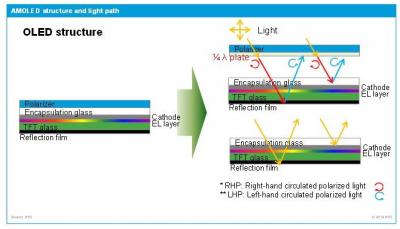According to the Korea Herald, Samsung Electronics demonstrated several new display technologies in a private room during the Mobile World Congress last month. All of these technologies are expected to enter production within the next year or two, according to the source quoted by the report.
1,200 PPI AMOLED for VR
The report claims that Samsung demonstrated a high-resolution AMOLED panel for VR applications. The AMOLED on display featured a 1,200 PPI - much higher than Samsung's current highest density displays which are 577 PPI. Samsung's aim is to reach 1,500 PPI which will greatly enhance the VR experience.
In November 2016 Sunic Systems announced that it developed an plane-source evaporation-FMM based AMOLED production process that can reach very high densities. The 100um mask announced in November can achieve a PPI of 1,500. This may be the system that Samsung is now testing. Sunic says that eventually this technology will enable even 2,250 PPI.
In May 2016 Samsung Display demonstrated the 5.5" 3840x2160 panel you see above - which reaches 806 PPI. If SDC managed to produce a 1,200 PPI AMOLED in less than a year's time, that's a very nice achievement.
Polarizer-free OLED
The most interesting development is an AMOLED display without a polarizer film. The polarizer film is required in an AMOLED as it reduces reflections and increases contrast because it diverts light that enters the display from outside and bounces back from the TFT and the metal cathode.
A polarizer film adds to the thickness of the display (and to the cost) - but most importedly it also absorbs some of the light and so reduces the power efficiency and the brightness of the display. The image above (from IHS) shows the structure of an OLED display and why a polarizer is required.
It is not clear how Samsung managed to remove this polarizer. It may be that they are using a non-metal or non-reflective cathode (maybe a graphene based one?). Another possibility is that this display will only be adopted in VR headsets - in which case there is no external light, and so there is no need for a polarizer.
Blue-light free OLEDs
Finally, Samsung demonstrated a blue-less OLED display. The report says that this display is aimed toward people with color blindness. In May 2016 we saw a similar display at SID 2016, which Samsung branded as Bio-Blue. These displays should be healthier - check out the OLED Auditorium Lecture by National Tsing Hua University that describes the hazards of blue light and promotes the adoption of blue-light free OLEDs.
Samsung says that in a regular LCD, 66% of the light is in the blue spectrum. A regular OLED emits half the amount of blue light (32% of total emission) - while the Bio-Blue display emits only 6% blue light. The display demonstrated in 2016 looked very good and the reduced blue emission was not very noticeable.
Comments
Can you quote a study or something? Because the claims about PWM causing all sorts of health issues sound fishy to me considering that people used CRTs at 60Hz for many years basically just fine.
PWM is a way to control brightness, not to prevent burn-in.
CRT displays had luminophor that continued emitting light for some time after it’s formally off, so flickering was somewhat smoothed. With OLED, we have hard on/off with almost no afterglow.
I have sensitive eyes and after looking at my samsung galaxy s7 for half an hour my eyes start paining me, while I can look at my LG OLED tv all day long without any issues.
It's for both
How exactly could PWM prevent burn-in?



Samsung uses PWM technology in its OLEDs to prevent burn-in, but it causes eye pain, Does any of these new technologies will make it possible for samsung to get rid of PWM?
And what technology does LG uses to prevent burn-in?